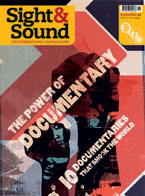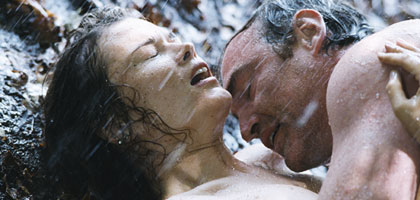
Love in the afternoon

There's no reason to nudge your neighbour or wink over Pascale Ferran's Lady Chatterley. For the French director has done what no Briton could: she has rehabilitated D.H. Lawrence's iconic 'dirty book', finding, in an earlier version, a young woman's record of becoming through unfolding passion. By Geoffrey Macnab
At one stage D.H. Lawrence contemplated Tenderness as a title for the novel he eventually called Lady Chatterley's Lover. Yet tenderness isn't what best describes its perception within British culture. Written in 1928, two years before the author's death, the book was too sexually explicit for its time and so wasn't published in the UK until 1960, when it was prosecuted and eventually cleared for public consumption under the terms of the new Obscene Publications Act. ("Is it a book you would wish your wife or servants to read?" famously asked the outmoded prosecuting counsel at the landmark trial.) For as Philip Larkin pointed out, times were changing: "Sexual intercourse began/In nineteen sixty-three/ (Which was rather late for me) -/Between the end of the Chatterley ban/And the Beatles' first LP."
Subsequently Lawrence's literary reputation, built up after his death by F.R. Leavis among others, declined from free-love-era reverence, through feminist vilification, to a more circumspect view today, summed up by Chris Barwick in The Cambridge Companion to D.H. Lawrence as "a symptomatic case study in the psychoanalysis of fetishism". And Lady Chatterley's Lover is thought of as among the least impressive of his novels.
But Lawrence wrote two other versions of the story, the second of which was only published in English in 1972, as John Thomas and Lady Jane. Released in France as Lady Chatterley et l'homme des bois, it is this little-known book that has now been made into a film by Pascale Ferran. The 47-year-old director's reputation rests on one feature film and a second made for television. The former, Petits arrangements avec les morts, which won the Caméra d'Or at Cannes in 1994, is a nuanced study of long-term grief played out among grown-up siblings who lost a sister in an accident when they were in their teens; the second, L'Age des possibles (1996), is a low-budget theatrical ensemble piece. The 11 years that have lapsed between her last film and Lady Chatterley (during which time she oversaw the dubbing of Stanley Kubrick's Eyes Wide Shut into French) are explained eloquently below, but Ferran's waiting for the right project is part of the same sensibility of acute responsiveness to mood and emotion that permeates her films.
These qualities gives Ferran's Lady Chatterley (which has won five Césars - the French equivalent to the Oscars) a very different tone from all previous attempts to bring the story to the screen. Harking back to Lawrence's original intentions, the French director has created a delicately crafted paean to passion that does justice to her view of the novel as a utopian tale of intoxicating love written with uncanny subtlety and sensitivity. As she says: "Lawrence really manages to get inside Constance's head, which is something Flaubert didn't do with Madame Bovary. He was the first male novelist in the west to write such a marvellous portrait of a woman."
The narrative remains familiar enough. The setting is the industrial Midlands in the early 1920s, where 27-year-old Connie Chatterley, a nervy, washed-out, discreet presence, is married to Clifford, a wheelchair-bound aristocrat who came home from World War I "more or less in bits" and compensates with exaggerated arrogance. Living a claustrophobic, time-dragging and sexless life in their stately home, she begins to explore the extensive grounds, opening herself eventually to an affair with the solitary, brooding gamekeeper (Parkin, not Mellors as he became in the third version), whom she meets for trysts in the woods.
There are other striking differences between the second and final versions of the book. As literary critic Roland Gant has written: "Connie Chatterley [in the second version] is less sophisticated, both intellectually and sexually, than she is in Lady Chatterley's Lover. She is more womanly, just as Clifford is a more convincing crippled man, bent on transforming his impotence into potent industrial and political power, than the Clifford of the final version... Parkin, outwardly rougher than Mellors, is more gentle as man and lover."
The language used to describe the sex is less blunt and explicit in John Thomas and Lady Jane than in Lady Chatterley's Lover. Lawrence was working on the notorious final version at the time of the General Strike, and the tone became more satirical and polemical, with the class antagonism at the story's core more pronounced (for instance, Mellors is contrasted with the newly introduced character of Michaelis, an effete and supercilious playwright with whom Connie also has an affair). Ferran doesn't ignore the class tensions, treating them as part of the atmosphere of the house that Connie is escaping. So we hear Clifford telling his wife that "the masses want only one thing: masters" and watch her staring at the blackened faces of the miners returning home from the pits. ("Men not men but merely the animae of coal and steel, iron and clay," Lawrence wrote of the way she saw them.) Yet Ferran's Lady Chatterley is also about the way Connie and Parkin overcome class differences to reinvent their lives, meeting in the magical, hermetic space of the forest, where they achieve a pre-lapsarian innocence.
Like Lawrence himself, Ferran portrays nature as a mysterious living influence. Trees sough gently in the breeze and clearings surprise us with carpets of delicate blooms in vivid colours. As spring spreads its banquet, so do Connie and Parkin open themselves to the elemental. It may all sound a little postcard cute, but it's the very freshness with which Ferran displays this impressionist imagery and her unexpected lack of embarrassment about delighting in nature that make her film a joyful experience that transcends the Lawrence adaptations we've seen before. The extraordinarily fine-grained performance of Marina Hands as Connie, whose point-of-view prevails throughout, renders ironic distanciation an impossible perspective. Even scenes where the lovers deck each other's genitalia with flowers or run naked through the woods don't feel ridiculous.
Ferran's approach to Lawrence is the antithesis to Ken Russell's in Women in Love (1969) or in his 1993 television adaptation of Lady Chatterley's Lover. Where Ferran's storytelling is gentle and understated, Russell's version plays like an adult Gainsborough melodrama, as quickfire as Ferran's film burns slow. We have scenes of Connie running through the woods to meet her lover with loud orchestral music gushing on the soundtrack; "I'm yer ladyship's fucker," Mellors (Sean Bean) scowls at Connie (Joely Richardson) as he chops wood with an axe, naked above the waist to show off his manly physique. Contrast this rampant reductionism with the reticence of the scene in Ferran's film in which Connie sees Parkin washing himself outside his hut and flees in panic, as if terrified of his physicality.
The handling of the sex scenes in the French film shows a similar restraint - what predominates are shots of Parkin clumsily but affectionately removing Connie's stockings or pulling the burrs from her hair after they've made love. And in contrast to Russell's priapic males wrestling in the firelight in Women in Love, Ferran deals with Lawrence's phallocentricity - famously castigated in Kate Millett's Sexual Politics (1970) - by simply ignoring it, making no attempt to find a cinematic equivalent for passages about "the erect, sightless, overweening phallus... rising from the roots of his body... like some primitive grotesque god."
Where Russell's Lady Chatterley relies heavily on dialogue, Ferran cuts it down to a minimum, dividing her film into chapters with bridging passages of narration that she reads herself. And where Bean's Mellors is saturnine and dashing, Jean-Louis Coulloc'h's Parkin is shy and self-conscious. In the novel Lawrence refers to Connie's collection of modern pictures and "her very fine print of a Renoir nude" - and indeed Ferran frames Connie in certain sequences in a style reminiscent of a Renoir or Bonnard painting. Her aim, she has suggested, is to "look at everyday subjects with a totally new eye."
